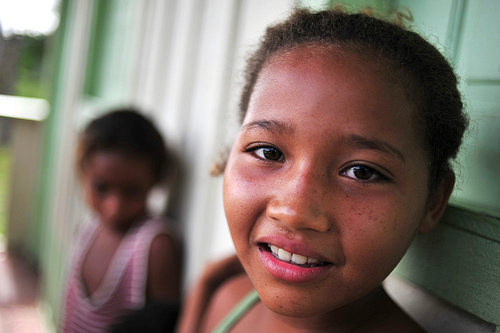 As Dr. Purvis would say, internationally adopted children come from hard places. These children are not in need of families because of happy circumstance or an ideal upbringing. Even when adopted at a young age, these children have experienced trauma that impacts their development for life. Dr. Purvis categorizes the type of trauma experienced by our children as “complex developmental trauma,” meaning the trauma impacts various areas of the child’s development. Parenting children with this type of trauma requires that parents are intentional when parenting. Trust-Based Relational Intervention (TBRI®) is a style of parenting thought by many to be the best type of parenting for these kids. TBRI® balances nurture and structure with the main purpose of connecting with the child, even when the child’s behavior requires correction.
As Dr. Purvis would say, internationally adopted children come from hard places. These children are not in need of families because of happy circumstance or an ideal upbringing. Even when adopted at a young age, these children have experienced trauma that impacts their development for life. Dr. Purvis categorizes the type of trauma experienced by our children as “complex developmental trauma,” meaning the trauma impacts various areas of the child’s development. Parenting children with this type of trauma requires that parents are intentional when parenting. Trust-Based Relational Intervention (TBRI®) is a style of parenting thought by many to be the best type of parenting for these kids. TBRI® balances nurture and structure with the main purpose of connecting with the child, even when the child’s behavior requires correction.
One of the pillars of TBRI® is that behavioral change can occur organically when the parent and child are connected. For children with behavioral problems, the misbehavior may be a result of the child being in survival mode. Survival mode causes the child to fight, flee or freeze when feeling threatened. For many of our children these survival techniques were necessary for their survival in their early days. When the child arrives home they cannot simply turn these behaviors off, they must build a trusting relationship with their parent through connection. When a child’s behavior is disrespectful and needs correction, TBRI® provides guidance on addressing these behaviors while building connection and trust with the parent. TBRI® uses the acronym “IDEAL Response” as a way to remember key steps in addressing and correcting the child’s behavior when such behavior needs correction.
Immediate: Once a negative behavior occurs, the response to the child’s behavior should be as immediate as possible. In an ideal world, the response should occur within 3-5 seconds. The immediacy of the response is so important because it facilitates better learning for these kids, especially those with cognitive impairment. The idea here is to “run to the door, but walk in the room,” as Dr. Purvis would say. “Running to the door” means, the interruption of the behavior should happen right away. “Walking in the room” means the intensity by which you address the issue should be calm and steady. We would not want to say things like “just wait until your Father comes home, he will deal with this.” For children with lower cognitive functioning, the idea that a child would need to wait for the other spouse to come home to address the issue is not effective correction and would likely not encourage trust.
Direct: Parents should directly address the child and get the child’s attention before addressing the behavior. You will want to be face-to face with the child and may ask the child for eye-contact. You will want to be close to the child by proximity and may also want to physically touch the child if appropriate (holding the child’s hands, touching the child’s arm, etc.). To be directly in front of the child you may also match the child’s behavior. An example of matching the child’s behavior, would be sitting in front of the child Indian style if the child is sitting on the floor Indian style. The idea here is that you do not want to have an imposing stance to invite any fear in the child causing them to fight, flee or freeze, you want to work towards resolution together.
Efficient: You do not want to lecture your child. Parents should use short phrases and redirect the behavior, give the child two choices or permit the child to ask for a compromise. For instance, a child is crying because she wants to be carried inside and it is not appropriate for the child to be carried at the time. Parents may give the child two choices, you would offer that the child can walk by your side or hold your hand and walk by your side (notice being picked up was not one of the choices). This allows the child some control and problem solving while still correcting the behavior.
Action-Based: These kids are often functioning from the base of their brain (brain stem) when they are in survival mode. They often are not being willfully defiant, but rather their default mode of operation is to fight, flee or freeze. One of the ways to have them learn a new way to behave is to ask that they model that appropriate behavior creating motor memory, so that they learn how to behave in a tangible way. For instance, for the crying child who wants to be picked up, you may say to the child “why don’t we try that again with respect.” Then you would go to the location where the child started crying and have the child ask to be picked up in a respectful manner, then you could pick the child up and they learned to ask for what they needed instead of melting down. In TBRI®, one of the goals of the parent is to give the child a voice so that they can learn to ask or what they need.
Leveled at Behavior: It is vital for these children that the correction that they receive from parents is leveled at or directed to their behavior. The corrections must be about the child’s behavior, not the child’s worth. This may be the most difficult aspect of practicing TBRI®. It can be difficult to think about the behaviors as separate and apart from the child. Keeping in mind that the child is behaving as they know how based on past trauma, it’s the job of the parent to give them new tools and teach new behaviors to be able to implement while reassuring the child that they are loved and they are precious.
The heart of TBRI® parenting is connecting with the child, the IDEAL Response allows for parents to correct the child’s behavior while building trusting relationships with the child.
Photo Credit: CIFOR
Derived or reproduced from Trust-Based Relational Intervention® resources (Purvis & Cross, 1999-2013).
